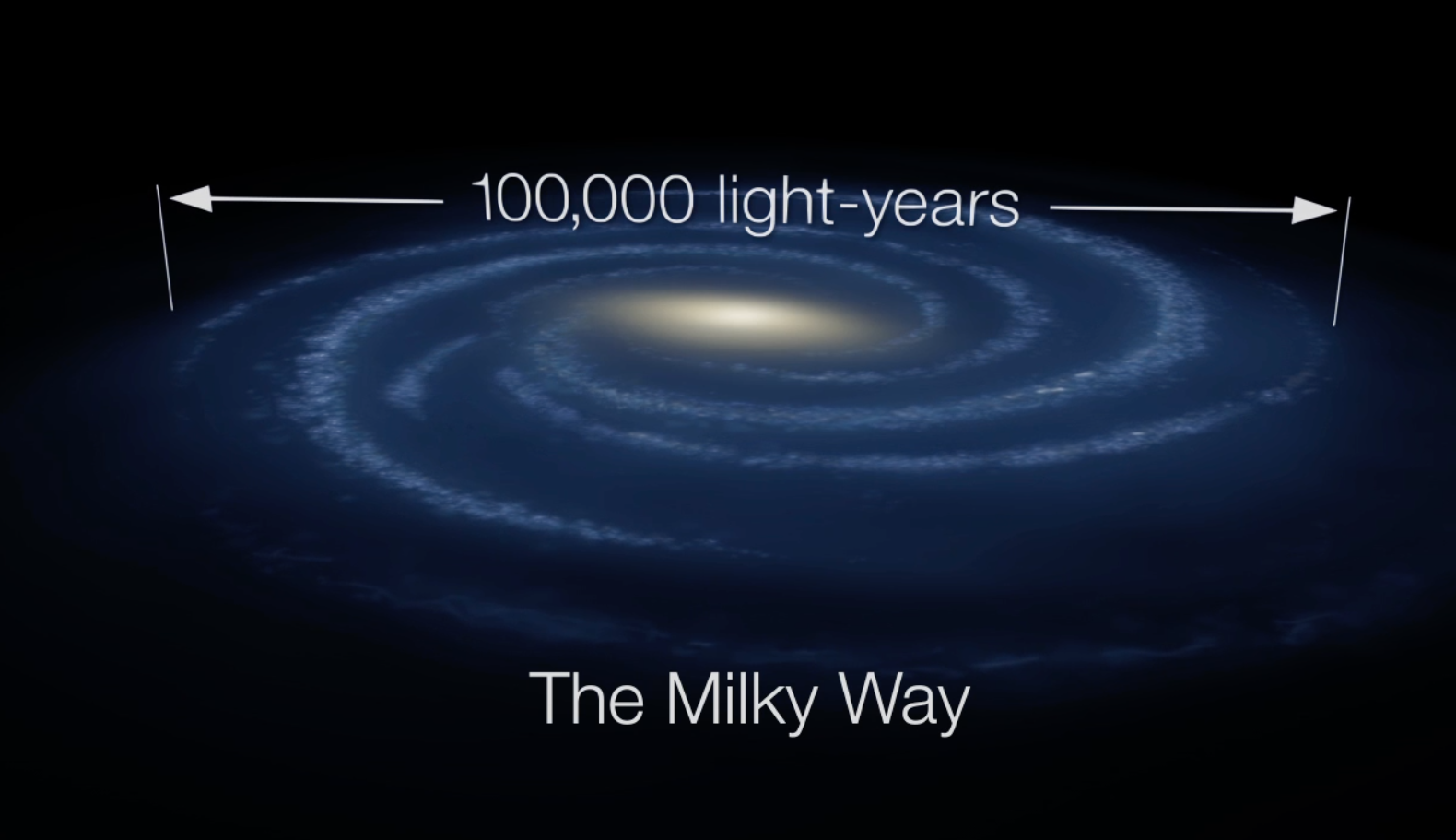Posted on 06/26/2021 6:07:24 PM PDT by LibWhacker
“A Perilous Journey” –Our Solar System Has Completed 20 Orbits of the Milky Way
![]()
In 1999 astronomers focusing on a star at the center of the Milky Way, measured precisely how long it takes the sun to complete one orbit (a galactic year) of our home galaxy: 226 million years, bobbing our fraught journey through the disc of the Milky Way, drifting through ghostly spiral arms and the darkness of dense nebulae, keeping a constant 30,000 light years between Earth and the violent galactic core. The last time the sun was at that exact spot of its galactic orbit, Tyrannosaurus rex ruled the Earth.
A Three-Dimensional Ballet
Our orbit through the Milky Way is not a perfect circle or an ellipse, since the galaxy itself is a landscape of undulating concentrations of mass and complex gravitational fields. “None of the components of the galaxy are stationary,” writes Columbia University astrophysicist Caleb Scharf in The Copernicus Complex,” they, too, are orbiting and drifting in a three-dimensional ballet. The result is that our solar system, like billions of others, must inevitably encounter patches of interstellar space containing the thicker molecular gases and microscopic dust grains of nebulae. It takes tens of thousands to hundreds of thousands of years to pass through one of these regions.”
The Solar System is thought to have completed about 20–25 orbits during its lifetime or 0.0008 orbits since the origin of humans. When the last white embers of our Sun dim and die out billions of years from now, we will have completed approximately 60 orbits of our home galaxy.
It’s estimated that the Sun will continue fusing hydrogen for another 7 billion years. In other words, it only has another 31 orbits it can make before it runs out of fuel.
Our solar system undulates up and down through the midplane of the galactic disk, completing nearly three undulations per orbit around the Milky Way. Our Sun is currently located 56 light years above the galactic plane, but reaches vertical heights of more than 300 light years. It takes the Sun about 80 million years to undulate up and down, Meanwhile, older thick disk stars extend up to a few thousand light years above and below the midplane of our Galaxy.
Journey Through the Interstellar Medium
As our Sun orbits the Milky Way and bobs up and down through the disk, the density of surrounding gas and dust changes drastically –regions where stars and gas are a little closer together than elsewhere in our galaxy’s disc.
Currently, the density of the interstellar medium in the local solar neighborhood is about one atom per cubic centimeter. However, when the Sun periodically passes through a molecular cloud every few hundred million years or so, the density rises to several hundred to several thousand atoms per cubic centimeter, with serious potential consequences here on Earth.
Researchers at Cardiff University suggests that our system’s orbit through the Milky Way encounters regular speedbumps – and by “speedbumps,” they mean “potentially mass-extinction-causing asteroids.”
The solar system now inhabits an unusually empty patch of space, the local bubble, with only one hydrogen atom per five cubic centimetres of space. In the past we must have drifted through much denser gas clouds, including some more than 100 light years across in whose cold and dark interiors hydrogen forms itself into molecules.
“This may happen only once every few hundred million years,” Scharf adds, “but if modern human civilization had kicked off during such an episode, we would have barely seen more than the nearest stars— certainly not the rest of our galaxy or the cosmos beyond. But could our planetary circumstances have been that different and still produced us? Would more changeable orbits in a planetary system, or bad weather, or passage through interstellar clouds, also thwart the emergence of life in some way?”
“So it’s a possibility,” Scharf observes, “that the planetary requirements for forming sentient life like us will necessarily always present the senses and minds of such creatures with a specific cosmic tableau, a common window onto the universe.”
A Milky-Way-Orbit Biodiversity Link?
If future research confirms a Milky Way galaxy-biodiversity link, it would force scientists to broaden their ideas about what can influence life on Earth. “Maybe it’s not just the climate and the tectonic events on Earth,” says University of Kentucky paleobiologist Bruce Lieberman. “Maybe we have to start thinking more about the extraterrestrial environment as well.”
“One of the key lessons gleaned from the study of the fossil record is that the physical environment has had a profound influence on evolution and extinction,” wrote Lieberman in an email to The Daily Galaxy. “As scientists have come to learn more and more about this topic, it is clear that our concept of the physical environment needs to extend beyond just considering the conditions on this planet, to instead also encompassing the conditions in the surrounding solar system and even the galaxy.”
“From asteroids to comets, and gamma ray bursts to supernovae, several important astronomical phenomena have played a major role in perturbing biodiversity on our planet,” continued Lieberman. “Indeed, in the case of some of these phenomena, we are only just beginning to understand the role they played. Other astronomical and astrophysical phenomena may have influenced evolution and extinction as well, though this needs to be explored in greater detail. It is definitely an exciting time to be studying how events and conditions within our galaxy may have influenced life on this planet.”
The Daily Galaxy, Maxwell Moe, astrophysicist, NASA Einstein Fellow, University of Arizona via Bruce Lieberman, Caleb Scharf,The Copernicus Complex, Cardiff University, and New Scientist
Image credit: An international team of astronomers discovered that the Milky Way’s disc of stars becomes increasingly ‘warped’ and twisted the further away the stars are from the galaxy’s center. “We usually think of spiral galaxies as being quite flat, like Andromeda which you can easily see through a telescope,” says Professor Richard de Grijs, an astronomer from Australia’s Macquarie University.
Climate change.

When we pass Go do we collect $200.00?
Some of us have completed 60+ or more orbits around planet earth, at the rate of about 66,000 miles per hour, or 18 miles per second.
No wonder I’ve been dizzy for the past 58 years...

Oops!! Make that, 60 or more orbits around the SUN, not the earth! Lol!
I guess the solar system will survive the internal combustion engine.
ping
But if we all drive electric cars everything will be good, right.
Twenty (20)??
Dang! I must have lost count at 3...
Guess that means that Minkowski metric ain’t worth squat...
Lol! I messed up on that and said some of us have orbited the ((earth)) 60+ times.
With that said...

Since the only observations we have collectively made has only been a few decades, none of the stated “facts” have been observed. These are only hypotheses. And this is only if you accept the hypothesis that the earth is > 100,000 yrs old. Any of these calculations can only be gotened by computer models; similar to climate change computer models. And we know how reliable they are. Convenient to obtain grant money!
Seems impossible that there aren’t a zillion OTHER ‘Solar Systems’ with life forms of some kind in our expanding Galaxy.
A good reminder of how utterly insignificant we are in, ‘The Grand Scheme of Things’ when we get all worked up over one thing or another.
Just sayin’. :)
I guess I agree with that, that there has to be life elsewhere in the universe. But then, who the heck knows. Maybe we are all that there is.
Impossible to determine. Pure speculative nonsense.
Can you please explain how you came to the determination that it is impossible to determine how long it takes our solar system to orbit round the galaxy?
In reality we are a train wreck waiting to happen as we corkscrew through through the Galaxy...
Disclaimer: Opinions posted on Free Republic are those of the individual posters and do not necessarily represent the opinion of Free Republic or its management. All materials posted herein are protected by copyright law and the exemption for fair use of copyrighted works.